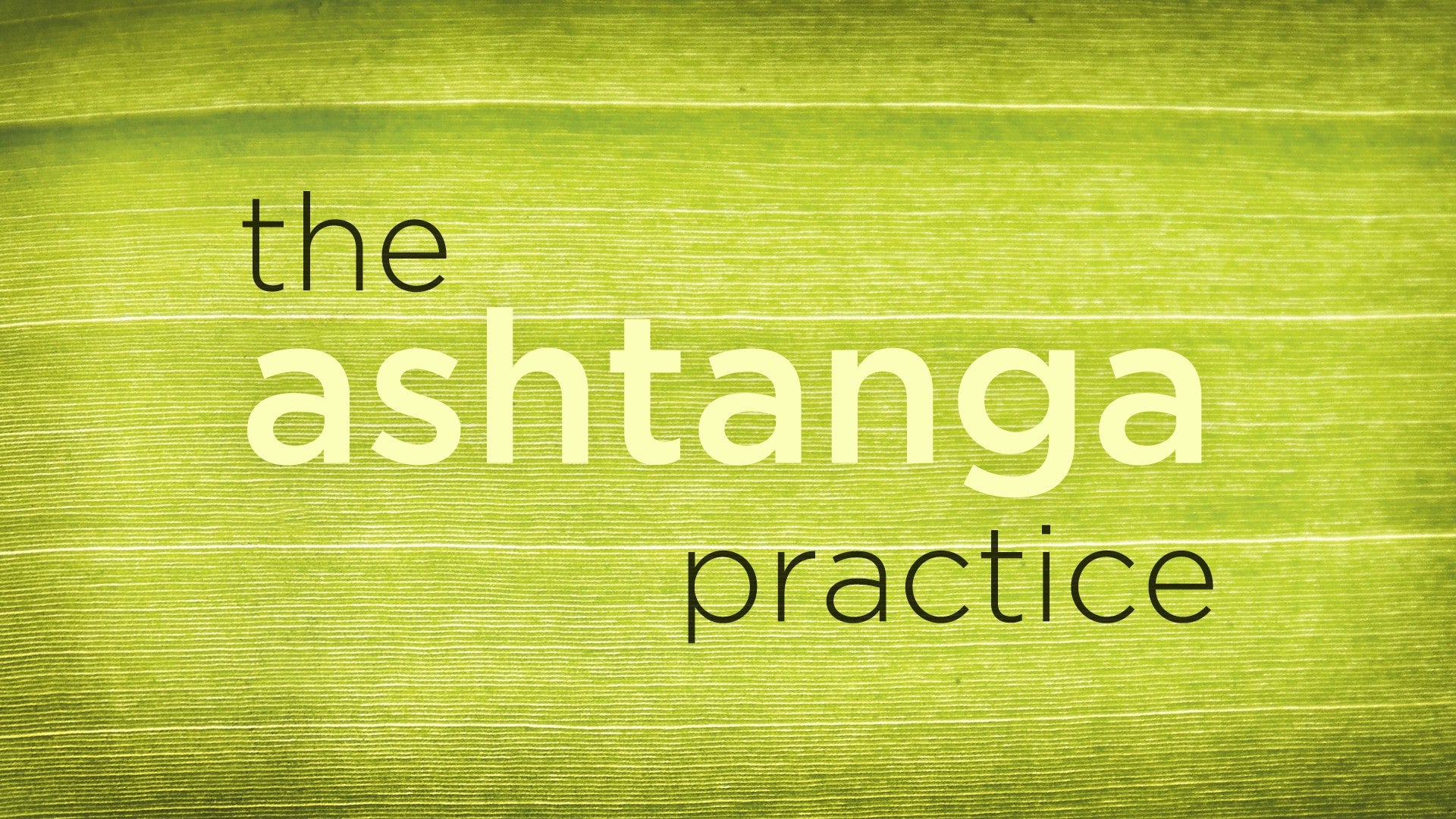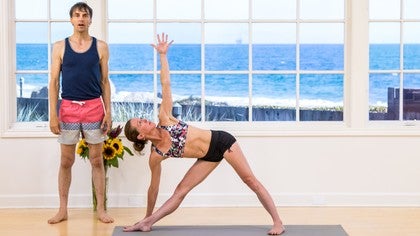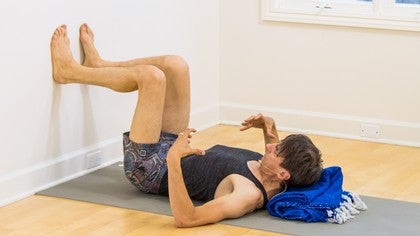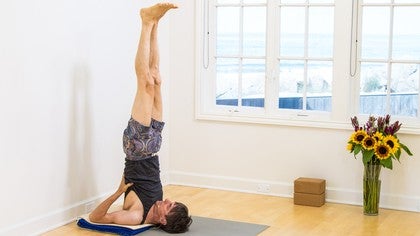Description
About This Video
Transcript
Read Full Transcript
(waves crashing) Greetings, welcome to session four of our intro to Ashtanga course. So today's theme we're continuing with looking at the standing postures. So remember the sequence we're working on starts with Surya Namaskara, the sun salutations, and then goes to a set of standing postures. So we're looking at in detail at those standing postures. And then our kind of limb theme is the fourth limb, Pranayama.
And so that's everything concerning breathing. And remember that the breathing, the breath, is your single best meditation technique. So that when you follow your breath, if you can train yourself to stay in touch with your breath, that is how you become centered in the body. That's how you still your mind, and enter into the sacred present moment, okay? And it's a crazy fact that we breathe in and out 21 600 times in 24 hours.
21 600 times! Imagine it! And how many of those do we notice? And so a yogi counts his life not in years but in breaths. And so the breath is your best ally you're constantly with that breath and enjoying it, but also co-creating, taking part in it. And so that's the kind of, principle to live by, is befriending your breath. Okay and so for this session we're gonna bring on a friend, Shelly, and she's gonna help us in the beginning.
Hi Shelly. Okay, so we are going to start by going through what we've already learned. So the Surya Namaskar A, and the group of standing posters. So here we go, Samasthiti. So your feet are together, you're enjoying your earth connection through the legs, lifting up the navel, opening the chest, and reaching down through the pinky fingers in an arm gesture.
So you're trying to reach through the arms and internalize the senses. So remember the zero position, Samasthiti, equal groundedness. Than here we go, with a breath in, inhale, reach up to first position, stop at the destination, and exhale, fold. Again stop in the complete fold with your weight shifted forward, your feet stamped into the earth/. So every position is a fit for meditation.
And then inhale, lift up the chest, project the spine away from the legs, bend your knees into a crouch, get ready. Spring to fourth position, and stop, hover there. And then inhale, roll over the tops of the feet, lift up the chest, look up and over, pull the hips back smoothly, roll over the tops of the feet again, and you come into sixth position, where you stay for several breaths. So you've got, if you happen to be looking at the camera, you can look, you're working this line, so the pelvis is tipped forward, and that diagonal line has integrity through each joint, okay. But the spine is also releasing downwards into the body.
And the breath is flowing smoothly. Then bend your knees into a crouch and get ready. Spring! Plant your feet, lift up the chest, firm the legs. Exhale, fold, keeping your weight forward. Balancing on your steady feet.
Inhale, reach out to the sides, the brilliance connecting your movement with your breath, and exhale, return to Samasthiti. And again, breathe in, reach, exhale, forward. So getting to your destination swiftly. Inhale third position, jump back to fourth position and finish breathing out with a steadiness. Inhale, open the chest with the magnificent expansion and pull the hips back smoothly to come into sixth position.
Listening to the sound of the breath. So remember the senses are inside the body, so you're kind of an internal gaze, that's steady even though you're looking somewhere up between the inner legs. And the ears are turned inwards to listen to the internal sound of the breath. And that breath is long and steady. The thighs are pressing back, the hands are pushing down.
So you're lengthening the spine by galvanizing the limbs. And then crouch as you empty the lungs, spring, plant the feet, lift up the chest, lengthen the legs, and exhale. Keep the weight forward, stop at the destination, inhale, sweep the arms up with the move. Stop, enjoy, and exhale to Samasthiti. Here we go with the standing postures.
Take the hands to the waist, crouch, and separate the feet with a hop. Lift up the chest, get ready, and then exhale halfway forward, catch your big toes, straighten the arms, shift your weight forward, breathe in, and then exhale forward with a move, pulling on your toes with your fingers, and stamping your feet into the earth. So you're lengthening the leg bones as you stay. Emptying the palate, emptying your gaze, steadying the breath. Enjoying your active limbs in contrast to your passive brain and receptive senses.
Draw the breath in, straighten the arms, So you'll transition, lift up the chest and then take the hands under the feet, and again lift the chest, shift your weight forward and exhale. Come into your position dynamically, and somehow matter of factly. So there's some detachment there, and yet such fire and passion. So you're balancing, stamping your feet, your hands down with your feet and pulling up against that. So the limbs stay active as the spine releases.
Then draw the breath in, steady and smooth, lift the chest, stop right here, shift your weight forward to the tipping point, and stay there as you empty the lungs and take the hands to the waist. So you'd enjoy that halfway point thoroughly, inhale, come all the way up, crouch and spring, return to Samasthiti. And here we go to Utthita Trikonasana, the extended triangle. Crouch and spring out to the right, angle the right leg out 90 degrees, the left foot in slightly, get ready, and then tip the pelvis, reach out and come down. So externally rotate the front leg thigh, clearly so the kneecap faces up, plant the feet, ground the thighs, and you're working to elongate the spine from the pelvic floor through the crown of the head.
And turn any amount so that project of revolving the torso, you want to get invested in that. And reach through the arms, and there's a steady gaze up past the thumb. So you're bending the front knee if necessary, and finding the right spot for the bottom arm. Inhale, come up with the move, change sides, get ready, so remember if you can see me for a moment, look at that pelvic tip. So it's a tip and an extension you're working on.
Come back up, and here we go, try, tip the pelvis forward, reach out, and come down, and then bend your knees, Shelly. I'm gonna have Shelly bend the knee, and catch your shin, so remember ... Bend the knee, so you can work like this, but remember if you're bending your knee, you're actually straightening it, but its not getting straight, okay? So you've got to find wherever that resistance is. And remember you don't want to do this, straighten the leg and then round this, see, whoa whoa whoa whoa.
See, if you insist on you leg being straight, and it compromises the rest of the body, it'd be better just to bend it a little bit so you can work on elongating and getting the full feeling of the horizontal length of the spine, okay? And then inhale, sweep that up by pulling into the top arm, and then we have the revolving triangle. So angle the back leg in 30-45 degrees, square the hips, lift up the arms, lift the kneecaps, quadriceps, lift the navel, and tip the pelvis, exhale, come down with the move. Now remember, you may have to bend the front knee, or use an option for where to put your hand. It might be on the inside of the foot, it might be on your shin.
Okay, find what works. Eventually it goes to the outside, and it can be on the finger tips, or you can plant the hand. Stamp the feet firm the thighs, elongate and turn. So you feel the whole body participate in an integrated way. And that takes practice, as you stay with the breath, that rhythm.
And then come up with a move, with an inhalation, and then change sides, exhale, so you ... Breathe yourself into position. And that also takes practice, but with the repetition, you're working it. So find the right spot for your bottom arm, as you stamp the feet down, scissor the legs together, juice the right kidney into the body, and lift the chest as you reach up through the top arm. This is a steady gaze up past the thumb.
And enjoy. Inhale, come up smoothly, crouch, and spring, return to the front, and enjoy Samasthiti. Okay, so the next, now that's where we've come to in our sequence. So the next posture is called Utthita Parsvakonasana, the extended side angle pose. So we're gonna have a look at that.
So just, uh, yes. So you want a wide stance, and uh, it has a two part transition that we're going to look at. Let's just show them the pose first. Okay, so this is the pose we're talking about. There's a lunge involved, and then that, the side angle, okay?
So diagonal line formed by the back leg, the torso, the top arm. And this front leg and front, or bottom arm, are connected. Okay, so come up Shelly. So we're gonna look at how we're gonna do that. So the first move is to create your lunge.
We go into what we call Virabhadrasana II, the warrior II position. It's like the triangle pose setup. Okay, so angle the right leg out 90 degrees, the left foot in slightly, and stretch the arms, and then simply make a move, come into a lunge, okay. And look at that lunge. Come back up.
So you want the pelvis neutral, okay? This posture, when you come into the lunge, go ahead Shelly, it will tend to tip the pelvis forward, and that, not forward, excuse me. It will tip the pelvis sideways and forward. But you're trying to keep it as neutral as possible. Very tough thing to do.
And you want the thigh to track from the hip to the knee in a straight line. So you don't want to end up like that. Okay, so come back up, and you're gonna try it with the move. So get your setup position, and then lunge into warrior II. And come up.
And lunge! So what's, find the destination. And come back up. So for you, some of you won't be able to get, cause what you're looking for, go ahead and get that lunge, is to get the thigh parallel to the ground. Oh my goodness! With the knee over the ankle, and the back leg straight. So that's a very challenging thing to do.
She's making it look easy, but it's not easy to do. And so you might go halfway down, yeah you might do it somewhere in the middle. That might be your personal destination. But make sure that this, that your, the feeling of the thigh is going that way. Even if you don't get all the way down.
And so that's totally different than if the thigh is going "No no, we gotta stand up, come on let's get outta here!" Okay, that's not what you want. So you're, even if it doesn't get all the way down there, it's going in that direction, okay? One more time, from the setup and come to your personal destination and stop. Alright, so now the next move is a dynamic. You (whoosh).
Okay, so you're reaching through that underside waist, and swinging the left arm, the top arm, over the ear on the diagonal, okay? So that's a tricky one. Come back up and try it. So you're in warrior II, oh yeah, (laughs) so you may have to come all the way up and out, alright. And then lunge, and then here we go.
Extend through the right side waist, and reach, and then when you get there, remember that the lower your hand is the harder the pose gets. Okay, so you can go up on your fingertips if you need to. And the important thing is the connection between this front knee and the front arm. You want to (whoosh). Stamp those together.
And look at the difference, if you push this away from that. See, don't, that, is a ... It takes away your power. Okay this give a lot of stability to the pose when you connect the front leg and the bottom arm. Okay, and inhale, come up, wow.
Phew. And you can feel that is a serious thigh burner, right? But you want to enjoy that. Okay let's try the second side. Okay so you've got your setup, it's just like triangle.
You've externally rotated the front leg, grounded the back leg, reach through the arms, and then lunge. And track the thigh straight from the hip to the knee. No no, come to warrior II, okay, and then the second move. Reach through the left side waist, swing the right arm over the ear, and go on to your fingertips, keeping the bottom arm straight, and connecting that left leg and left arm, clearly. So plant.
So it's a pushing the left knee against the left arm and resisting that pressure with the left arm. And then notice, oh actually, we will come up to warrior II and then out. Okay, so you come out in the reverse order. And step out for a little moment. Just step, take a little rest.
So that's the standing poses, very strong work in the feet, the legs, the pelvis. They're so good. And they're worth spending time researching and exploring and extra breaths. Okay, um. So actually, the standing postures are amazing in that they're the foundation.
So they're the place you start. And yet they're so complex, they're impossible! (laughs) It's a funny puzzle. It's like impossible riddles they give you. So even, you started as a beginner, but 30 years later, you're still puzzling over them. That's the beautiful thing about it actually.
So we're gonna go back and look at it again. And remember we worked on our triangle pose with no arms. And so you really want to emphasize the feet, the legs and the pelvis as supportive and as kind of sources of intelligence and focus. Alright so take your stance on the first side, and then keep Samasthiti arms. So you're not reaching out to the side, you've got Samasthiti.
And lunge into warrior II, and come up, and lunge. So back and forth like a toy soldier. Lunge, and, no no not quite so fast. Lunge, and connecting the movement with the breath. And lunge, and come up.
Okay and then lunge, and then throw the body into the side angle position, keeping the Samasthiti arms. And work. And then come back up to the warrior II, and then to the setup position, and go back down. Lunge, throw the body, elongate the spine, and try to turn any amount, okay. And then, look for a sec, the arms are there for show.
So you put that top arm, just keep it off the ground, but near the right foot, and this one swings over the ear. And then back to Samasthiti arms, and then again do that ... Arm move. Okay! And then up you come. And to the setup position and change sides.
Okay, Samasthiti arms and lunge, and come up. So you're exhaling every time you lunge. Inhale come up, exhale down. So connecting your breath with every move. Inhale up, and then lunge, and then throw the spine so the torso goes out on the diagonal, and elongates from the pelvic floor through the crown, as you reach in a Samasthiti move through the arms from shoulder to fingers.
And then take the arms for show, right near your foot, but don't touch the ground. And reach over on the diagonal and see how tough that is. And then place the hands, the bottom hand, go ahead and put it down, and reach the arm over, and feel. So you don't want to overuse that bottom hand, but it also you can see, whoa that helps. And then come up to warrior II with a move, straighten the leg, and return to Samasthiti.
The yoga gods, if Parsvakonasa wasn't hard enough, then they introduced the twisting side angle. Whoa, so we're gonna give it a go here. So she, get your stance, and then you're gonna do revolving warrior II, okay. And you're gonna do it by, remember that no no don't bend yet. So remember it's like the revolving triangle stance.
Angle your back leg in 45 degrees, and then square the hips, okay. And then come into a lunge, keeping your torso upright, and lift the back heel just off the ground. Just the littlest bit, its only this far off the ground. One half an inch. And then do it again, straighten the leg and lunge.
And twist, so spin, the whole spine staying as upright as possible. And straighten the leg to the setup position and lunge. So remember this is just like Parsvakonasana but with a twist so you can use all the same stuff. Lunge, and then go for the move. So you're going to not touch the ground.
You're gonna take your left arm to the outside of the right leg without touching the ground, and swing this top arm over the ear. And twist. And come back up. To the setup position, yes. And one more time.
Lunge into revolving warrior II, and then spin, lengthen the spine, and reach over the ear, with the top arm. And inhale, come up, change sides. So remember the revolving triangle setup. Angle your back leg in 45 degrees, square the hips, then go into a lunge, let the back heel come just off the ground, and spin! Keeping the whole torso as upright as possible. And then straighten the left leg, and again lunge.
And straighten, and again lunge, and then project the spine forward, take the right arm across the left without touching the ground, and reach the left arm over the ear. And come back up, and up and out. Okay so remember that the last move is so hard. You're making a gesture with your spine and arms. Try it one more time, first side.
Here we go, get your setup. And lunge into revolving warrior II, and then lengthen the spine and reach through the left arm, right arm twist and up you come. Try the second side, lunge into revolving warrior II, and then practice the gesture of finishing off the revolving side angle pose. So challenging! And then inhale come up, and return to Samasthiti. That completes our work on these two postures, and thank you Shelly.
So now we're gonna sit down and work with some seated postures for a few minutes. And notice I have two blocks and a blanket, if you have that at home you could grab that. Okay, so here we go. We're sitting down in Dandasana, it means staff pose. This pose is the Samasthiti of the seated asanas.
And here, but you've got two skeletal lines instead of one. And so you start building the shape by clarifying your pelvic position, okay. And so we know we've got neutral or backward tilt, or the forward tilt is kind of harder to get, but I want you to try it. And you'll try it like this. So separate your legs, bend your knees, and then it's like you want to get a big belly, okay?
And so you try to get the pelvis to tip forward and spill the belly forward. Like (groans), okay? And its a very interesting position, so reach and pull the flesh of the buttocks back, and feel that. So there's kind of the essence of seated forward bending positions. But you want to be able to feel that essence while you're doing the Dandasana, the neutral position.
And that can be a hard position to get with straight legs. Okay, so look at this. We've got kind of a frog look here, with the legs separated and the pelvis tipped forward, then push through the heels and straighten, and try to feel what is neutral. So many of you that pelvis will still remain tucked under, you won't be able to get it. So that's where the blanket comes in.
So I take it and the higher you go, the easier it is to get the neutral pelvis, or to tip is forward. So if you sit on there, then you can start to feel that pelvic action more easily. Okay, and only use as much height as you need to get to a neutral position. Alright and here we go. As usual it's a dynamic position, so reach the arms up and keep your eyes down.
So you're working to clarify the vertical line, and the wrist, elbow, shoulder, hip, lifting up the navel, planting the sitting bones and grounding the thighs. So then sweep the arms down and largely they're just there for show, look they're just hovering off the ground. And I'm creating my position, but then when you finally put them down and they give a little plus. They allow you to, so you stamp the fingers down, and they're back. They're placed next to the hips, and they help you to roll the shoulders back.
Okay so there's Dandasana, and then the next move is a forward bend that we call Paschimottanasana, the western stretching. So that's the back side of the body. So it's a forward bend that we're gonna do like this. Take your blanket, and if you weren't, if you were sitting on it already then stay there, otherwise, grab it, and again bend your knees, separate the feet. Bend the knees and we're gonna work on this move.
So you (breathes our forcefully). Kind of throw forward the torso, like wow! And reach back through the arms. And feel, stay right here once you've come forward, and lift the chest, elongate the belly. So I'm flexing the ankles, and then stay forward and slowly push out through the heels to straighten the legs. And bring them together.
Okay, so you're trying to get ... Wow, project the torso out over the legs. And come back up. So some of you will need to bend the knees in order to do that. But remember you're straightening the legs even if they don't get fully straight.
So you can choose your option, either with the blanket, with your feet apart ... So with the blanket with the feet apart, with the knees bent, all those options make it easier. But if you want more challenge then sit on the ground, straighten the legs, bring the feet together, and reach and catch your big toes. And then once you get a hold of the toes, you're wrapping the fingers around, pull and lift up the chest. Then with the move, exhale forward.
Keep a good grip on your toes. Any bit, try to feel your thighs anchoring. And so the length, you're elongating from the very base the navel pulls forward, the whole spine lengthens, and you drop the torso down towards the legs. Then inhale halfway up, straighten the arms, and enjoy this transition position. So the arms and legs are getting as straight as possible as you lift up the spine.
And some back to Dandasana. Couple of things before we finish doing this particular thing. Is the, your legs and your pelvis, you want to keep them in mind. So right, you don't want to end up like this. Working on your forward bend, rounding your back, and keeping your legs straight, and hoping that you get down there.
So you're (exhales deeply) And so the knee bending, separating the legs, and not going as low are your best options. Okay so for instance, suppose you're tighter, then you can use that blanket, but also separate the feel a little bit and try this. Plant your hands on your shins, and pull towards you. Pull towards you and elongate, keep your head down. Okay so you can work like this.
This is in substitute, instead of catching the toes and going down here, you can stay up here more. And straighten the legs and pull. Okay and if you look at this method, the whole body is involved. The legs are grounded, the arms are kinda pulling, and engaged, and then you slowly will work it forward and forward and forward as you develop it. And one last thing is this no hands.
If you don't want to rely on those hands too much either. The actions are coming from your legs and your pelvis and your belly. So right here just feel that amazing position, right so dynamic and awake, which is very different than what I call the schlog which is kind of like this. (laughs) okay? So (moans).
Have to make the body come alive. And kind of take it step by step. Alright, so now we're gonna lay back in Shavasana. And enjoy the corpse pose. So lay down into Samasthiti, so the feet are together, the ankles flexed.
So reach all the way through the arms from shoulder to fingertips. And enjoy that you have the ground beneath you to help you identify the vertical line from the crown of the head through the soles of the feet. And from there it decomposes, so you separate the hands and feet. Let the body fall and be caught by the earth. Shut the eyes.
Relax. All of the senses, the eyes, the ears, the skin. The palate. They all just become receptive. So you're not trying to see or hear or feel, just simply receiving whatever comes.
And tune in to that cycle of breath it comes and goes with an ebb and a flow with a contraction and an expansion again and again. And you're tuning into that ebb and flow. Sometimes you're taking part in it, and enhancing it, or expressing movement with it, and sometimes simply watching, letting it ... Unfold ... All by itself, spontaneously.
So you can stay in Shavasana for some time, on your own, or come up and out. I'm gonna come up and out. Before we finish off this session, I want you to return to that, kind of, contemplation of the fourth limb, of breathing. So that's something that ... You're constantly coming back to.
It's a theme, just returning, returning. And you want to look for that returning to that theme in unlikely places. So like in all your transitions, so when you lunge into Parsvakonasana, like, it's like your breath, your breath is the puppeteer, and your body is the puppet. Okay so that no movement, that puppeteer, he's manipulating all the movements of the puppets, right? As an unseen player, and that's your breath.
So every move is orchestrated by breathing, and by the contraction, expansion rhythm. And that takes a lot of time, a lot of patience and practice, to kind of centralize your whole approach to practice in breathing. But that's your aim In exploring this kind of life principle of breathing, and of the fourth limb. So that's it for today's session. See you tomorrow! Namaste.
The Ashtanga Practice: David Garrigues
Comments

You need to be a subscriber to post a comment.
Please Log In or Create an Account to start your free trial.







